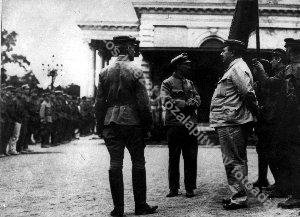Following the model laid out by Lenin, the newly united Socialist Party created a government called the Revolutionary Governing Council, which proclaimed the Hungarian Soviet Republic and dismissed President Károlyi on March 21. Initially, this government consisted of a Socialist-Communist coalition led by Sándor Garbai, but Kun, as Commissar of Foreign Affairs (foreign minister) was the real power in the country. Under Kun, the Communists leaped into action and managed to dismiss the Social Democratic ministers within days. Afterwards, the new Communist government decreed the abolition of aristocratic titles and privileges, the separation of church and state, and they codified the freedom of speech and assembly, free education, language and cultural rights to minorities (the latter four ideals were not implemented in practice).
The Communist government also nationalized industrial and commercial enterprises, and socialized housing, transport, banking, medicine, cultural institutions, and all landholdings of more than 40 hectares. The public support for Communists was also heavily dependent on their promise of restoring Hungary's borders.
In a radio dispatch to the Russian SFSR, Kun informed Lenin that a "dictatorship of the proletariat" had been established in Hungary and asked for a treaty of alliance with the Russian SFSR, to defend against the inevitable hostile reaction from the Entente. The Russian SFSR was willing, but unable to lend a helping hand to the fledgling Hungarian Soviet Republic, because it was itself tied down in the Russian Civil War. The Hungarian government was thus left on its own, and a Red Guard was established under the command of Mátyás Rákosi. In addition, a group of 200 armed men - known as the Lenin Boys - formed a mobile detachment under the leadership of Cserny József. This detachment was deployed at various locations around the country where counter-revolutionary movements were suspected to operate. The Lenin Boys, as well as other similar groups and agitators killed and terrorised many people (for example, they blasphemed openly, or armed with hand grenades and using their rifles' butts, disbanded religious ceremonies). This caused a number of conflicts with the local population, some of which turned violent.
Communist policies
The Hungarian Soviet Republic, in a dangerous strategic position next to hostile Romania and Czechoslovakia, was invaded by Romania in mid-April 1919. Some of Hungary's agricultural lands were seized, and the Romanian army threatened Budapest. Outvoting the Social Democrats, the Communists decided to keep fighting, using the Red Guard volunteers to stop the Romanian advance and seize a significant portion of Czechoslovakia. The Hungarian Soviet sought to cut open a corridor through Czechoslovakia to the RSFSR. This however worsened the Entente's view of the Communists. On June 8 American President Wilson demanded a halt to the Hungarian Red Army's advances and invited the Hungarian government to Paris to discuss Hungary's frontiers. Kun still hoped to link up with Russia and spearhead the worldwide workers' revolution in Southern Europe. A spurious Slovak Soviet Republic was proclaimed on June 16, in the southern and eastern Slovakia.
 Downfall
DownfallTibor Szamuely
Aftermath of World War I
Revolutions of 1917-23
Hungarian Revolution of 1956
Red Terror
No comments:
Post a Comment